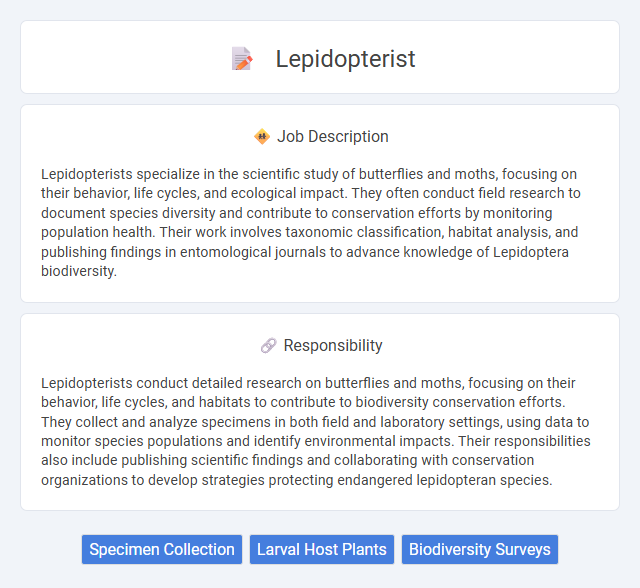
Lepidopterists specialize in the scientific study of butterflies and moths, focusing on their behavior, life cycles, and ecological impact. They often conduct field research to document species diversity and contribute to conservation efforts by monitoring population health. Their work involves taxonomic classification, habitat analysis, and publishing findings in entomological journals to advance knowledge of Lepidoptera biodiversity.
Individuals with a keen interest in insects and a patient, detail-oriented nature are likely well-suited for a lepidopterist job, as the role often involves extensive fieldwork and meticulous specimen analysis. Those who prefer outdoor activities and have the ability to work in various weather conditions may find this career particularly fulfilling. Conversely, people who struggle with patience or have difficulty focusing on repetitive tasks might face challenges in this profession.
Qualification
A lepidopterist typically requires a bachelor's degree in biology, entomology, or a related field, with advanced positions favoring a master's or Ph.D. specializing in lepidoptera. Essential skills include extensive knowledge of butterfly and moth species identification, taxonomy, and ecological research methods. Experience in fieldwork, specimen collection, and data analysis using scientific software enhances job prospects within academic, conservation, or museum settings.
Responsibility
Lepidopterists conduct detailed research on butterflies and moths, focusing on their behavior, life cycles, and habitats to contribute to biodiversity conservation efforts. They collect and analyze specimens in both field and laboratory settings, using data to monitor species populations and identify environmental impacts. Their responsibilities also include publishing scientific findings and collaborating with conservation organizations to develop strategies protecting endangered lepidopteran species.
Benefit
A career as a lepidopterist likely offers the benefit of contributing to biodiversity conservation through the study of butterflies and moths. It may provide opportunities for fieldwork in various ecosystems, fostering a deeper understanding of environmental health. The role probably supports scientific research that can influence ecological policies and education.
Challenge
Lepidopterists likely face challenges in accurately identifying butterfly and moth species due to their vast diversity and subtle morphological differences. Fieldwork may involve navigating difficult terrains and unpredictable weather, which can hinder data collection efforts. The probability of encountering rare or endangered species increases the complexity and responsibility of conservation-focused research.
Career Advancement
Lepidopterists specializing in butterfly and moth studies can advance by obtaining advanced degrees in entomology or ecology, leading to research or academic positions. Experience in fieldwork, specimen collection, and data analysis enhances opportunities for roles in conservation organizations, museums, or government agencies. Publishing scientific papers and participating in conferences are crucial for career growth and recognition in this scientific community.
Key Terms
Specimen Collection
Lepidopterists specialize in the collection and preservation of butterfly and moth specimens, utilizing techniques such as netting, bait traps, and light traps to capture diverse species. Accurate specimen collection involves detailed field notes on habitat, behavior, and environmental conditions to support scientific research and biodiversity studies. Proper handling and storage methods ensure specimens remain intact for morphological examination and genetic analysis.
Larval Host Plants
Lepidopterists specializing in larval host plants study the specific plants that caterpillars feed on during their developmental stages, which is crucial for understanding butterfly and moth ecology. Identifying and cataloging these host plants helps in habitat conservation and supports the survival of various Lepidoptera species. Research in this field involves field sampling, plant-insect interaction analysis, and contributes to biodiversity preservation efforts.
Biodiversity Surveys
A lepidopterist conducting biodiversity surveys systematically collects and identifies butterfly and moth species to assess ecosystem health and species distribution. These surveys provide critical data for conservation strategies, enhancing understanding of habitat quality and the impacts of environmental change. Detailed observations and specimen records contribute to long-term monitoring and support biodiversity management initiatives globally.
 kuljobs.com
kuljobs.com